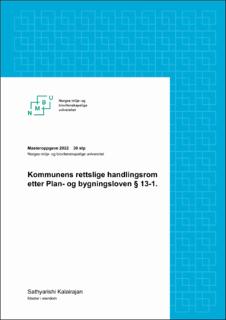| dc.contributor.advisor | Fredrik Holth | |
| dc.contributor.author | Kalairajan, Sathyarishi | |
| dc.date.accessioned | 2023-04-11T16:27:09Z | |
| dc.date.available | 2023-04-11T16:27:09Z | |
| dc.date.issued | 2022 | |
| dc.identifier | no.nmbu:wiseflow:6726460:52490029 | |
| dc.identifier.uri | https://hdl.handle.net/11250/3062459 | |
| dc.description.abstract | Plan- og bygningsloven § 13-1 gir kommunen hjemmel til å nedlegge midlertidig forbud mot tiltak. Bestemmelsen sikrer kommunen et vidt handlingsrom når det kommer til å endre planer. Midlertidig forbud mot tiltak kan omtales som å være en sikkerhetsventil. Hensynet bak pbl. § 13-1 er at kommunen skal få tid til å jobbe med ny plan, samtidig som at verdiene som skal vernes i ny plan ikke blir eliminert. De andre bestemmelsene i kapittel 13 harmoniserer sammen med pbl. § 13-1 når det nedlegges midlertidig forbud mot tiltak. Midlertidig forbud mot tiltak resulterer i at det mer eller mindre blir stans av alt arbeid som kan komme i konflikt med en ny plan – det gjelder både søknadspliktige og ikke- søknadspliktige tiltak.
Rettsvirkningen av et midlertidig byggeforbud er at byggesøknaden settes i bero. Det vil få betydning for nye søknader, og for allerede innsendte søknader. For private utbyggere kommer det frem at de også kan få dekket sine prosjekteringskostnader jf. (Ot.prp.nr.32 (2007-2008), s. 37). Rettspraksis setter begrensning på at det kun gjelder kostnader knyttet il søknaden.
I 01.06.22 ble det vedtatt midlertidig forbud mot tiltak – småhusplanen. Dette vedtaket ble begrunnet med at grøntarealer skulle bli bedre ivaretatt. 27 727 eiendommer ble omfattet av dette vedtaket. Flesteparten av innspillene som kom inn til vedtaket var negative ettersom vedtaket var inngripende, og senest 24.11.22 kom det et ønske fra Byrådet om at byggesøknader som er i tråd med nye småhusplanen skal kunne behandles.
Plan- og bygningsloven sier ikke noe om terskelen for å nedlegge midlertidig forbud mot tiltak etter pbl. § 13-1. Det kommer frem av bestemmelsen er at kommunen eller vedkommende myndighet kan legge ned midlertidig forbud mot tiltak de finner ut at et område bør undergis ny planlegging.
EMK (Den Europeiske menneskerettighetskonvensjonen) anser ethvert tiltak som begrenser rådighetsbegrensning som et inngrep i eiendomsretten. For å vurdere om det resulterer til brudd på EMK P1-1 må hvert enkelt tiltak vurderes om det foreligger hjemmel, om det foreligger allmenn interesse bak inngrepet og om det er proporsjonalt. | |
| dc.description.abstract | Section § 13-1 of the planning and Building law gives the municipality authority to impose a temporary ban on measures. The provision ensures the municipality a wide margin of maneuver when it comes to changing plans. Temporary prohibition of measures can be referred to as being a safety valve. The reason behind pbl. § 13-1 is that the law provision lets the values that needs to be safeguarded in the new regulation plan be saved. The other provisions in chapter 13 harmonizes well with pbl. Section 13-1 when a temporary ban on measures is imposed.
The legal effect of a temporary building ban is that the building application is put on hold. It will have significance for new applications, and for applications already submitted.
On 01.06.22, a temporary ban on measures (Småhusplanen) was made active in a certain area in Oslo. This decision was justified by the fact that green areas should be better looked after. 27 727 properties were affected by this decision. Most of the feedback from the people was negative. On 24.11.22 there was a request from the city council that the building applications that are in line with the plan should be able to proceed.
The Planning and Building law do not say anything about the threshold for placing a temporary ban on measures under the Planning- and Building Law § 13-1. The only thing that appears from the statutory provision is that the municipality or the competent authority can impose a temporary ban on measures if the municipality or the competent authority finds that the area should undergo new planning. The only thing the municipality/state authorities must consider is meeting the deadlines according to the Planning and Building Act under certain circumstances.
The European Convention on Human Rights considers any measure that restricts access to property to be an interference with property rights. To assess whether it results in a breach of Protocol 1, Article 1: Protection of property, each measure must be assessed as to whether there is a legal basis, whether there is a public interest behind the intervention and whether it is proportionate. | |
| dc.language | nob | |
| dc.publisher | Norwegian University of Life Sciences | |
| dc.title | Kommunens rettslige handlingsrom etter Plan- og bygningsloven § 13-1. | |
| dc.type | Master thesis | |
